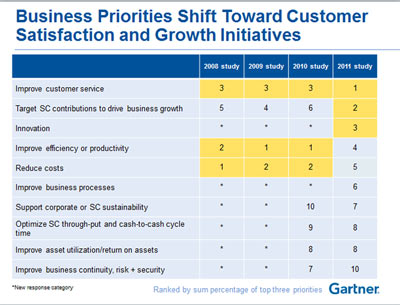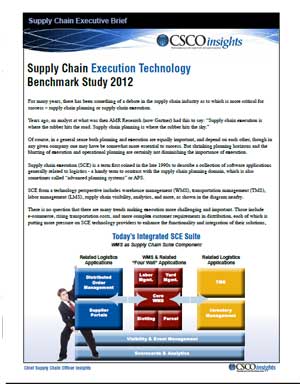 |
January 10, 2013 - Supply Chain Newsletter |
 |
FEATURED SPONSOR - MHIA |
 |
|
 |
|
||||||||||||||||||||||||||||||||||||||||
Supply Chain Year in Review 2012
|
|||||||||||||||||||||||||||||||||||||||||
| GILMORE SAYS: |
"Amazon.com is on track to have opened a staggering 18 more DCs in 2012. Consultants pushing services to help companies avoid being "Amazoned." The one company Walmart fears." WHAT DO YOU SAY? |
For the last four years, I put the supply chain and the economy at the top of the themes list, as economic considerations (mostly a weak economy) sort of dominated supply chain thinking and strategy. I am not doing that this year, as it was a fairly calm 12 months, even if economic growth was still weak, the never-ending financial woes in Europe played on, China's economy softened, etc. This appears to simply be the so-called new normal. We have just adapted to it.
That said, in rough order of import, here are the top trends I identify in supply chain and logistics over the past year:
Multi-Channel Madness: We've been talking about multi-channel commerce and fulfillment for years, but in 2012 it started to get really serious, with companies, especially retailers, spending a lot of money to bolster capabilities and optimize the "customer experience." Macy's says it is partially converting almost 200 existing stores to support ecommerce fulfillment. Walmart, Amazon, the USPS, eBay and others testing same day delivery services. Almost everyone giving away shipping and trying to figure out how to make money at it. There is some serious stuff going on right now in multi-channel.
Amazon Rising: Relatedly, Amazon.com's continued rise starts to put real fear into retailers, wholesalers and more as it grows its network and revenues at an unbelievable clip, and may just run away with this ecommerce thing. Best Buy, with almost an electronics monopoly in brick and mortar, struggles mightily in 2012, likely to be taken private, as "showrooming" hammers sales. Amazon growing at 30% or more quarter after quarter, likely ending the year with more than $60 billion in revenue, and will become the second largest retailer in a few years. On track to have opened a staggering 18 more DCs in 2012. Consultants pushing services to help companies avoid being "Amazoned." The one company Walmart fears.
Continued Hope for US Manufacturing: Optimism about a US manufacturing "renaissance" continued strong in 2012, especially in the first half of the year, with mixed actual evidence. GE CEO Jeff Immelt writes article in Harvard Business Review saying company is done chasing low labor rates around the globe. Research from MIT, Boston Consulting Group and others suggests a real corporate interest in keeping manufacturing in US or bringing some back from offshore, as rising Chinese labor rates and flat US ones make US more competitive, and companies focus on "regional" manufacturing strategies.
But is it real? There were certainly some examples (e.g. Caterpillar chooses Georgia for new factory over offshore options, Apple says it will again started building PCs in the US), but as a JC Penney supply chain exec noted at the CSCMP conference in October, the reshoring seems to be coming in drips and drabs, while the offshoring happened very fast. We'll see.
 Labor Takes a Beating: Again not unrelated to the trend above, union labor had a very rough 2012, even with its friends in the administration and the National Labor Relations Board. Union-heavy Michigan voters strongly shot down a referendum that would have guaranteed union rights in November, and in December legislators there made Michigan the 24th "right to work" state over fierce opposition, joining Indiana, which made the same move in 2011. Unions come out on the short end in high profile strikes at Caterpillar (which some called "labor's last stand"), Cooper Tire and others.
Labor Takes a Beating: Again not unrelated to the trend above, union labor had a very rough 2012, even with its friends in the administration and the National Labor Relations Board. Union-heavy Michigan voters strongly shot down a referendum that would have guaranteed union rights in November, and in December legislators there made Michigan the 24th "right to work" state over fierce opposition, joining Indiana, which made the same move in 2011. Unions come out on the short end in high profile strikes at Caterpillar (which some called "labor's last stand"), Cooper Tire and others.
A judge (for now at least) threw out in June the "microwave election" rules the NLRB had earlier passed to speed up union voting, though it will likely be back in play soon. So, not a good year for labor, but you can guarantee it will reload soon.
White House Stays with Democrats: Obama wins second term, which in practical terms means a number of regulatory measures that in general could be construed to be against pure supply chain interests likely to go forward. Hours of Service changes will become law in July of this year, increasingly stringent moves on greenhouses gas by regulations rather than law likely to continue (though EPA head Lisa Jackson, who was leading that charge, just resigned), the NLRB as noted above likely to regroup in favor of unions, and move to consider contract truck drivers as full-time employees of a company (and thus subject to unionization) are among the key potential issues.
Merger Mania Continues: The consolidation of nearly every sector in supply chain technology continued in 2012, most prominently the planned merger of JDA Software and RedPrairie, two of the industry's largest software providers, in a move that will have major ramifications.
Just as surprising was May's announcement that SAP would acquire procurement technology leader Ariba. Industrial giant Honeywell in December announced it would acquire data collection provider Intermec, after acquiring Intermec rival LXE the year before, the same year Intermec acquired voice technology provider Vocollect, leaving the sector highly consolidated - basically, Honeywell and Motorola Solutions are the two giants left standing, with Psion and a few others smaller players still around.
Most surprising of all though was Amazon.com's acquisition of robotic picking system provider Kiva Systems in March for an amazing $775 million – and what it will do with this capability is still unclear (though we are pretty sure Kiva sales reps are no longer calling on Walmart.com).
Intermodal Rocks On: The consistent shift by many US shippers to intermodal continues apace, with carloads up 3.1% over 2012 and just under the record set in 2006 (while truckload tonnage is up slightly less). But that masks a bit the more aggressive growth of intermodal freight outside of coal, shipments of which fell dramatically in 2012. But looking at individual carrier results tells that stronger tale: JB Hunt's intermodal revenue was up about 16% through Q3; Swift's intermodal business was up 41% in Q3.
Natural Gas Reaches A Tipping Point: Though a measure to provide cheap loans for natural gas truck purchases died in the Congress, momentum continued, with interest and adoption rising throughout most of the year. Clean Energy Fuels and Shell both announce and began executing aggressive plans to develop natural gas filling stations in partnership with major truck stop chains. The ATA holds major and successful conference on natural gas trucks. Beyond trucking, low cost of US natural gas literally fueling major manufacturing investments in the "rust belt" and beyond in sectors such as chemicals, fertilizers and metals. First new US fertilizer plant being built in more than 20 years.
Momentum also building to change law to allow exporting of US natural gas overseas, which could lead to US being the Saudi Arabia of natural gas. All this together will simply transform the US economy.
There's more, but those are the top trends and themes from my view. I would have added a still greater and deeper focus on supply chain risk management and the green supply chain going sideways (ups and downs) if I had more space.
Next week, look for 2012 timeline in On-Target and a review of 2012 in numbers and charts in this column as well.
2013 will mark the 10th year anniversary of Supply Chain Digest (I can't believe it has been a decade), and look for special stuff from us this year.
Any reaction to Gilmore's 2012 key supply chain themes and trends? What would you add? Let us know your thoughts at the Feedback button (email) or section below.
![]()
| View Web/Printable Version of this Page |
|
|
|
YOUR FEEDBACK
Some feedback this week on our recent First Thoughts column on the supply chain challenges of multi-channel commerce, including our feedback of the week from Steve Murray of Supply Chain Visions.
We also have a few brief letters with some nice things to say about the inaugural Supply Chain Network by Design column by our new expert columnist Mike Watson of Northwestern University. His first column was on "Advanced Analytics."
Feedback of the Week: Multi-Channel Commerce Challenges
Thanks for another thought provoking set of questions about an evolving environment.
If we think about retail sales with the consumer at one end and the manufacturer at the other, the shortest and simplest approach would appear to be B2C direct from the end of the manufacturing line. However, appearances can be deceiving, particularly when long distances are involved. This is why we have distribution networks. And manufacturers are far more capable of building pallets to ship in full truckloads than they are to send single retail units of multiple SKUs to a consumer address. The driving force is the consumer, and today the consumer wants and expects extremely rapid delivery. Even same day delivery. And, they expect discounted pricing on-line and free shipping to boot. If that wasn't enough they want to be able to go to a brick and mortar store to examine the product prior to purchase, then after making on on-line purchase take the product back to a fixed location for credit if they decide they don't want it. How in the world does the B&M retailer get compensated for their part in this deal? Lots to think about. Not only how the dot-com channel can make money, but how the traditional stores can as well. Somebody certainly needs to come up with an tenable solution. Steve Murray |
||
| More on Multi-Channel: | ||
Some of the comments in the article from"experts' reflect the failure to recognize that there is still some difference between e- or m-commerce buyers and brick-and-mortar buyers. Of course the best buyers move between these categories, but they between them because of different expectations of each channel. For example, most buyers who want same-day access to a product are willing to go to the store themselves ... I expect demand for same day delivery of online orders to remain limited both overall and limited to very high density cities, such as NYC. But further, the staff which operates B2B and B2C warehouses continue to need help recognizing the differences between serving these two market segments. Sharing inventory is potentially valuable, but after that the functions between to differ widely. Operators need to both recognize and understand those differences. Many, if not most, still don't. It's important to provide a very low cost shipping method - low cost and slow. Customer should pay for speed.
Direct Commercial Advisors
|
||
The buzzword in today's retail space is Omnichannel. Check out Retailigence.com for online search to offline purchase (O2O) capabilities that retailers and mobile apps developers are subscribing to their "data as a service" and location based marketing. Amazon does real time order and inventory optimization throughout the day and treats their shipping lanes as almost a fixed cost. The more volume per lane the greater the "margin per box." Wal*Mart is the sleeping giant in Internet sales and is about to wake up. They are the only "long tail" bricks and mortar retailer that can compete with Amazon on a global basis. Meijer has been very successful with its omnichannel strategy; but, they are still pretty regional on the bricks and mortar side. They still have the most optimal cost structure in the industry. The rumor is that Amazon is going to open some retail outlets; buy, they won't be physical long tail stores. They will be more trendy in all likelihood; but, they will have difficulty competing in the omnichannel space. In the more traditional space, Macy's and Nordstrom's are competing quite well in omnichannel. It will be interesting to see if Wal*mart will go into more upscale categories as it beefs up its Internet presence. Traditionally, those shoppers don't shop at Wal*Mart because they can afford not to. Amazon, Nordstrom, Macy's, and others show upscale shoppers go online. With Walmart.com, the shopper doesn't physically have to go into the store. And, don't count out BestBuy... some innovative O2O and same day delivery strategies are forthcoming.
Rich Sherman
|
||
| On Advanced Analytics in the Supply Chain: | ||
Nice final thoughts and I agree that analytics "is the ability to use data to make better decisions." Another interesting aspect that we can draw from this (apart from what the data is telling us) is what the data is not telling us. In fact, it is the "not-telling" that contributes to a greater degree of complexity. Koh Niak Wu, Ph.D.
|
||
| Great article Mike. It may be too late to worry about "Analytics" becoming a buzzword. Just like "analysis", "analyst" or "optimize" it's become part of the general vocabulary and has lost much of it's clarity. I think I moved to calling what I do "Advanced Analytics" as a way of highlighting that analytics can't all be done in Excel.
For the people buying such software and services this is a crucial thing to understand - just because it says analytics on the box does not mean you will get anything more than simple reporting when you use it. In fact, if my experience is at all representative, if its says "analytics" there is an excellent chance you will find nothing beyond reporting and perhaps visualization/alerting tools. If what you need is a predictive model, you had better understand what constitutes "predictive analytics". Personally I tend to use the "What happened?", "What if?" and What's Best" categories to explain different sorts of analytics but perhaps it's time for me to make a change. Andrew Gibson |
||
Concise and on point without hyperbole! Thanks, Dr. Watson!
|
SUPPLY CHAIN TRIVIA ANSWER
Q: What are the "3 P's" of task management in a Warehouse Management System?
A: Priority, Permission and Proximity – those factors are used to determine which worker is given what task to do, usually through an RF terminal or voice command.
| © SupplyChainDigest™ 2003-2012. All Rights Reserved. SupplyChainDigest PO Box 714 Springboro, Ohio 45066 |
POWERED BY: XDIMENSION
|








